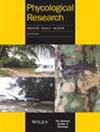Selective utilization of phosphorus compounds by Chaetoceros tenuissimus (Bacillariophyceae): Approach using 31P nuclear magnetic resonance analysis
IF 1
4区 生物学
Q2 MARINE & FRESHWATER BIOLOGY
引用次数: 2
Abstract
Several diatom species can utilize various forms of organic phosphorus via enzymatic hydrolysis. The present study identified which phosphorus compounds are preferentially utilized by planktonic diatom Chaetoceros tenuissimus cultures using a 31P nuclear magnetic resonance (NMR)‐based method. Our 31P NMR analysis, which involves a sample extraction procedure using DIAION™ CR11, detected and quantified phosphorus compounds present at concentrations of at least 7.5 μM in the seawater‐based media, including orthophosphate, phosphate monoester, phosphate diester, phosphonate, and other compounds. Based on this analysis, we examined the temporal variations of phosphorus compounds in C. tenuissimus cultures in which orthophosphate, phosphate monoester, phosphate diester, and phosphonate compounds were present simultaneously. Cells pre‐grown under phosphorus‐replete conditions utilized orthophosphate as the preferential phosphorus source and switched to phosphate monoester after exhausting orthophosphate. Enzymatic activity for phosphate monoester hydrolysis, namely phosphomonoesterase (synonym to alkaline phosphatase) activity, appeared when C. tenuissimus began to utilize phosphate monoester. In contrast, C. tenuissimus pre‐grown on phosphorus‐depleted media simultaneously hydrolyzed phosphate monoester and phosphate diester compounds, released orthophosphate from these compounds, and utilized the released orthophosphate and original orthophosphate without discrimination. Overall, we demonstrated that 31P NMR‐based method can comprehensively analyze the variations of dissolved phosphorus compounds in diatom cultures. Our results showed selective utilization of phosphorus compounds by C. tenuissimus and suggested that phosphate monoester and phosphate diester compounds were important phosphorus sources for this diatom in orthophosphate‐depleted coastal waters.细毛毛犀(Bacillarophyceae)对磷化合物的选择性利用:31P核磁共振分析方法
几种硅藻可以通过酶水解利用各种形式的有机磷。本研究使用基于31P核磁共振(NMR)的方法确定了浮游硅藻细毛藻培养物优先利用哪些磷化合物。我们的31P NMR分析,包括使用DIAION的样品提取程序™ CR11,检测并定量了海水介质中浓度至少为7.5μM的磷化合物,包括正磷酸盐、磷酸单酯、磷酸二酯、膦酸盐和其他化合物。在此分析的基础上,我们检测了细柄木培养物中磷化合物的时间变化,其中正磷酸盐、磷酸单酯、磷酸二酯和膦酸盐化合物同时存在。在磷充足条件下预生长的细胞利用正磷酸盐作为优先磷源,并在耗尽正磷酸盐后改用磷酸酯。当细叶木开始利用磷酸单酯时,出现了磷酸单酯水解的酶活性,即磷酸单酯酶(碱性磷酸酶的同义词)活性。相比之下,在贫磷培养基上预生长的细杆木同时水解磷酸单酯和磷酸二酯化合物,从这些化合物中释放出正磷酸盐,并毫无区别地利用释放的正磷酸盐和原始正磷酸盐。总之,我们证明了基于31P NMR的方法可以全面分析硅藻培养物中溶解磷化合物的变化。我们的研究结果表明,细叶藻对磷化合物的选择性利用,并表明磷酸单酯和磷酸二酯化合物是该硅藻在正磷酸盐缺乏的沿海水域中的重要磷源。
本文章由计算机程序翻译,如有差异,请以英文原文为准。
求助全文
约1分钟内获得全文
求助全文
来源期刊

Phycological Research
生物-海洋与淡水生物学
CiteScore
3.60
自引率
13.30%
发文量
33
审稿时长
>12 weeks
期刊介绍:
Phycological Research is published by the Japanese Society of Phycology and complements the Japanese Journal of Phycology. The Journal publishes international, basic or applied, peer-reviewed research dealing with all aspects of phycology including ecology, taxonomy and phylogeny, evolution, genetics, molecular biology, biochemistry, cell biology, morphology, physiology, new techniques to facilitate the international exchange of results. All articles are peer-reviewed by at least two researchers expert in the filed of the submitted paper. Phycological Research has been credited by the International Association for Plant Taxonomy for the purpose of registration of new non-vascular plant names (including fossils).
 求助内容:
求助内容: 应助结果提醒方式:
应助结果提醒方式:


